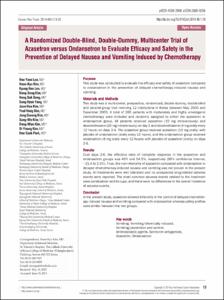KUMEL Repository
1. Journal Papers (연구논문)
1. School of Medicine (의과대학)
Dept. of Internal Medicine (내과학)
A Randomized Double-Blind, Double-Dummy, Multicenter Trial of Azasetron versus Ondansetron to Evaluate Efficacy and Safety in the Prevention of Delayed Nausea and Vomiting Induced by Chemotherapy
- Keimyung Author(s)
- Song, Hong Suk
- Department
- Dept. of Internal Medicine (내과학)
- Journal Title
- Cancer Research and Treatment
- Issued Date
- 2014
- Volume
- 46
- Issue
- 1
- Abstract
- Purpose : This study was conducted to evaluate the efficacy and safety of azasetron compared to ondansetron in the prevention of delayed chemotherapy-induced nausea and vomiting.
Materials and Methods : This study was a multi-center, prospective, randomized, double-dummy, double-blind and parallel-group trial involving 12 institutions in Korea between May 2005 and December 2005. A total of 265 patients with moderately and highly emetogenic chemotherapy were included and randomly assigned to either the azasetron or ondansetron group. All patients received azasetron (10 mg intravenously) and dexamethasone (20 mg intravenously) on day 1 and dexamethasone (4 mg orally every 12 hours) on days 2-4. The azasetron group received azasetron (10 mg orally) with placebo of ondansetron (orally every 12 hours), and the ondansetron group received ondansetron (8 mg orally every 12 hours) with placebo of azasetron (orally) on days 2-6.
Results : Over days 2-6, the effective ratio of complete response in the azasetron and ondansetron groups was 45% and 54.5%, respectively (95% confidence interval, -21.4 to 2.5%). Thus, the non-inferiority of azasetron compared with ondansetron in delayed chemotherapy-induced nausea and vomiting was not proven in the present study. All treatments were well tolerated and no unexpected drug-related adverse events were reported. The most common adverse events related to the treatment were constipation and hiccups, and there were no differences in the overall incidence of adverse events.
Conclusion : In the present study, azasetron showed inferiority in the control of delayed chemotherapy-induced nausea and vomiting compared with ondansetron whereas safety profiles were similar between the two groups.
Key words: Vomiting, Vomiting/chemically induced, Vomiting/prevention and control, Antineoplastic agents, Serotonin antagonists, Azasetron, Ondansetron
- Keimyung Author(s)(Kor)
- 송홍석
- Publisher
- School of Medicine
- Citation
- Hee Yeon Lee et al. (2014). A Randomized Double-Blind, Double-Dummy, Multicenter Trial of Azasetron versus Ondansetron to Evaluate Efficacy and Safety in the Prevention of Delayed Nausea and Vomiting Induced by Chemotherapy. Cancer Research and Treatment, 46(1), 19–26. doi: 10.4143/crt.2014.46.1.19
- Type
- Article
- ISSN
- 1598-2998
- Appears in Collections:
- 1. School of Medicine (의과대학) > Dept. of Internal Medicine (내과학)
- 파일 목록
-
-
Download
 oak-aaa-00834.pdf
기타 데이터 / 252.64 kB / Adobe PDF
oak-aaa-00834.pdf
기타 데이터 / 252.64 kB / Adobe PDF
-
Items in Repository are protected by copyright, with all rights reserved, unless otherwise indicated.